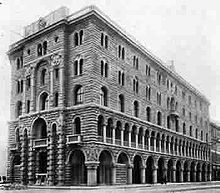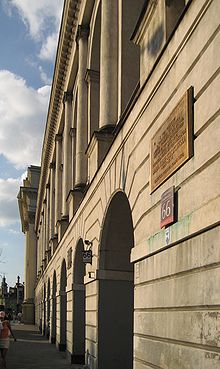- Wawelberg
-
Hyppolite Wawelberg

The Wawelbergs were an Imperial Russian banking house with roots in Congress Poland.
Contents
Name
The House of Wawelberg, The Wawelberg Bank (Банкирский Дом Вaвельбергов, "Вавельбергъ") Hyppolite Wawelberg (Russian Ипполит Адреевич Вавельберг, Polish Hipolit Wawelberg) Michail Wawelberg (Russian Михаил Ипполитович Вавельберг)
Hyppolite Wawelberg
 Wawelberg Bank building, St. Petersburg
Wawelberg Bank building, St. Petersburg
The Russian branch was founded by Hyppolite Wawelberg (Ипполит Адреевич Вавельберг, 1843–1901). The first Wawelberg Bank had its origins in a loan office that began operating in the early 1840s. In 1869 young Hyppolite Wawelberg moved to St. Petersburg where he launched a new venture, the Wawelberg Bank. Hyppolite Wawelberg's Polish-Jewish connections (Wawelbergs were Jewish) remained strong, and the bank was generally known as having two separate centers - in Warsaw and in St. Petersburg. The first location of Wawelberg Bank was 25 Nevsky Prospekt in St. Petersburg (House of the Parish of Our Lady of Kazan Cathedral, now housing Stockmann department store and SAS - Scandinavian Airlines System offices). Hyppolite Wawelberg made a fortune in Russia though he was equally well known as a generous philanthropist.
The new Polish Kingdom (Polish: Królestwo Polskie; Russian: Korolevstvo Polskoe), as created by the Congress of Vienna, was a Polish entity but was in personal dynastic union with Imperial Russia, since the reigning Romanov tsar was also king of Poland. Though based in St. Petersburg, the Wawelbergs were instrumental to the development of finance in the Polish Kingdom. They were to Congress Poland what the Medicis were to Florence, the Fuggers to Augsburg, the Rothschilds to France, and the Mellons to the late-19th-century United States.
By 1900 Hyppolite Wawelberg was at the helm of the Wawelberg Bank and held the title of honorable citizen of St. Petersburg, an appellation that could be passed on like a title of nobility. He was also a member of the management board of the Warsaw Bank of Commerce (Bank Handlowy w Warszawie). Back in St. Petersburg he was a member of the treasury of the Jewish Colonist Society, honorable member of the Jewish Educational Society (Общество распространения просвещения среди евреев) and benefactor of the Roman Catholic Beneficial Society (Римско-католического благотворительное общества).
In 1875, in Warsaw, Poland, Hyppolite Wawelberg co-founded the Museum of Industry and Agriculture (Muzeum Przemysłu i Rolnictwa w Warszawie). It was in a physics laboratory there that, in 1890–91, Maria Skłodowska (Marie Curie), future investigator of radioactivity and future double Nobel laureate, did her first scientific work.
In 1895 Hyppolite Wawelberg founded the Warsaw Mechanical-Technical School with his faithful friend and collaborator, Stanislav Rotwand (Cтанислав Ротванд, Stanisław Rotwand), an 1860 alumnus of the University of Saint Petersburg law school.
Michael Wawelberg
Michael Wawelberg (Михаил Ипполитович Вавельберг; 1880 – after 1929) received a classical educational at the St. Nicholas Imperial Gymnasium in Tsarskoe Selo (Царскосельская Императорская Николаевская гимназия), from which he graduated in 1899. His father Hyppolite Wawelberg donated 500 roubles for the gymnasium's own charity, which at the time was a considerable sum of money.
in 1903 Michael Wawelberg graduated from the University of St. Petersburg law school. That year he also took over the management of the Wawelberg Bank, which in 1912 was renamed the St. Petersburg Commercial Bank (Петербургский Торговый банк). In 1913 a branch was founded in Poland and became a publicly-traded company – the Western Bank (Bank Zachodni) in Poland). The Wawelbergs later lost control of it due to Russian Bolshevik-induced turmoil, but the bank survived all the 20th-century troubles. In 2001 it merged with the Great Polish Credit Bank (Wielkopolski Bank Kredytowy) and changed its name to Bank Zachodni WBK. Later it became part of the Allied Irish Banks and is still one of the largest banks in Poland.
In 1910 the St. Petersburg Commercial Bank purchased a building with a lot underneath it in one most prestigious locations, at the corner of Nevsky Prospekt and aristocratic Malaia Morskaia ulitsa (7 and 9 Nevsky Prospekt). The bank declared an open competition for the construction of the building. The competition was won by young Russian architect Marian Peretiatkovich (Peretyatkovich).
Naom Sindalovskii quotes a telling local St. Petersburg legend about building's construction. According to the legend after the building was constructed and the client (Michael Wawelberg) inspected it and could not find any deficiency with the work, he ordered to change the doors anyway because the door sign said "push." That's not what I do in life, said Wawelberg, I only pull things toward myself.
In 1917 on the eve of the Bolshevik putsch Michael Wawelberg lived in Czarskoe Selo at 66 Boulvardnaia ulitsa (66 Boulevard Street, ул. Бульварая, 66, Soviet name Октябрьский бульвар, Oktiabr'skii Boulevard). He was the chairman of the Commercial Bank and director of the board of Donetsk and Grushev Coal and Anthracite Mines (директор правления Донецко-Грушевского акционерного общества каменно-угольных и антрацитовых копий).
He fled Russia after 1917 and then disappears from the public view. Most likely he settled in Poland or spent some time there, because in Andrei Serkov's book on Russian Free Masonry he mentions that two free masons, Alexander Erdman and Michael Wawelberg (М. И. Вавельберг), as they considered themselves Russian, petitioned Grand Manster of the Polish Lodge with a request to allow them to found the Russian Lodge in Warsaw.
In St. Petersburg the Wawelbergs are best remembered because of the Wawelberg Bank building still popularly known as the House of Wawelberg (Дом Вавельберга) at 7/9 Nevsky Prospekt.
See also
References
- List of alumni, Law School (Law Faculty), University of St. Petersburg, 1860.
- Naom Sindalovskii - St. Petersburg, from Building to Building, 2002, Наум Синдаловский, Петербург от Дома к Дому. 2002
- Entire Petrograd, the Address Directory - 1917, Suvorin's Publishing - Весь Петроград. 1917. Петроград. Изд-во А.С.Суворина. 1917.
- Andrei Serkov. The History of Russian Free Masonry from 1845 to 1945. Chapter 9. Андрей Серков. История русского масонства (1845–1945). Глава 9.
- Naom Sindalovskii - St. Petersburg Biographical Dictionary, 2002, Наум Синдаловский, Биографический словарь, 2002
- Nevsky Prospekt - the architectural guide (Boris Kirikov, Ludmila Kirikova, Olga Petrova) - Cetropoligraph, Moscow, 2004 -(Невский проспект - Архитектурный путеводитель, Б. М. Кириков, Л.А. Кирикова, О.В. Петрова), Центрополиграф, Москва, 2004
Categories:- 1843 births
- 1901 deaths
- Polish Jews
- Polish bankers
Wikimedia Foundation. 2010.

